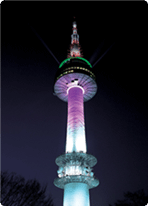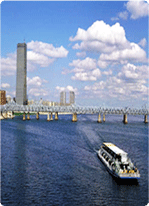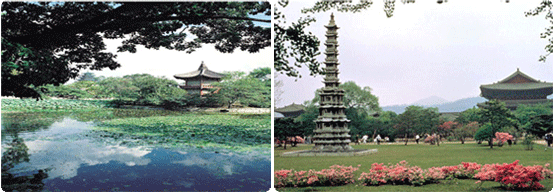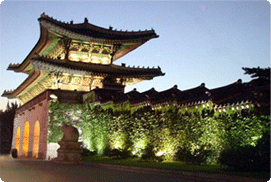| Seoul is the capital of Korea with over 600 years
of history. The ancient capital of an ancient land, Seoul is a city
where the traditional and the cutting-edge exist side-by-side in
perfect harmony. It's a dynamic city that never sleeps, and the
list of things to do is endless, from sampling the outstanding cuisine
served in the city's excellent restaurants to climbing the rock
faces that overlook the city. Come to Seoul, and learn why so many
travelers fall in love with this fast-paced but relaxing city.
 Seoul Tower has been designated as a major
tourist attraction where the beautiful panoramic view of Seoul can
been seen. The 236.7 meter high Seoul, Tower built on the 243m Mt.
Namsan has been known as the best tower in Asia. With the theme
of 'Flower of Seoul', lighting with the use of 6 different searchlights
from different angles will take place from 7p.m. to midnight. The
lobby is prepared with Media Zone, Pavilion Experience Hall, exhibitions
and performances. The N Grill western-style restaurant that revolves
360 degrees every 48 minutes, and Sky Restroom offering comfort
and scenic view of Seoul are high recommended places to visit. Furthermore,
N Seoul Tower has resuscitated as a complex cultural are from a
mere observatory.
Seoul Tower has been designated as a major
tourist attraction where the beautiful panoramic view of Seoul can
been seen. The 236.7 meter high Seoul, Tower built on the 243m Mt.
Namsan has been known as the best tower in Asia. With the theme
of 'Flower of Seoul', lighting with the use of 6 different searchlights
from different angles will take place from 7p.m. to midnight. The
lobby is prepared with Media Zone, Pavilion Experience Hall, exhibitions
and performances. The N Grill western-style restaurant that revolves
360 degrees every 48 minutes, and Sky Restroom offering comfort
and scenic view of Seoul are high recommended places to visit. Furthermore,
N Seoul Tower has resuscitated as a complex cultural are from a
mere observatory.
 Hangang River Ferry Cruise is one of the
best ways to enjoy the scenery around Hangang River that flows through
Seoul. Cool wind from the river, the surrounding scenery, which
get more beautiful in the evenings, are the rewards the ferry cruise
can offer you. On the cruise, you can see Hangang River's beautiful
scenery, the surrounding islands, Jeoldusan Park, the 63 Building,
Namsan Tower, Jamsil's Multi Sports Complex, and other famous tourist
spots. The cruise is often used for weddings, birthday parties,
music performances and other events. The live concerts connect piano
playing with singing voices, and will live on in memories. During
the summer, the docks also offer motor boat rentals.
Hangang River Ferry Cruise is one of the
best ways to enjoy the scenery around Hangang River that flows through
Seoul. Cool wind from the river, the surrounding scenery, which
get more beautiful in the evenings, are the rewards the ferry cruise
can offer you. On the cruise, you can see Hangang River's beautiful
scenery, the surrounding islands, Jeoldusan Park, the 63 Building,
Namsan Tower, Jamsil's Multi Sports Complex, and other famous tourist
spots. The cruise is often used for weddings, birthday parties,
music performances and other events. The live concerts connect piano
playing with singing voices, and will live on in memories. During
the summer, the docks also offer motor boat rentals.

Cheonggyecheon Stream
To make Seoul an environmentally viable city for residents in the
21st century, the project to restore Cheonggyecheon Stream began
on July 1, 2003. The clear blue waterway was revealed on Octorber
1, 2005. The restoration of Cheonggyecheon Stream is a remarkable
step toward making Seoul a city where nature, culture and history
exist in harmony.

Insa-dong, located in the middle of the city, is an
important place where old but precious and traditional goods are
on display. There is one main road in Insa-dong with alleys on each
side. Within these alleys are galleries, traditional restaurants,
traditional teahouses, and cafes. The shops in Insa-dong are very
popular among all age groups, because each store is unique. There
are about 100 galleries in the area and you can see every example
of Korean traditional fine art from paintings to sculptures. The
most famous galleries are Hakgojae Gallery, which functions as the
center of folk art, Gana Art Gallery, which promotes many promising
artists, and Gana Art Center. The best way to visit these galleries
is to use the "Art Center Bus". It will take you over
10 of the most famous galleries at a very reasonable price. The
teahouses and restaurants are the perfect compliments to the galleries.
There are traditional performances and exhibits as well.

Gyeongbok Palace was destroyed by a fire during the
Japanese Invasion of Korea (1592-1598) but the Palace (7.700 rooms)
was later restored under the leadership of Heungseondaewongun in
the years of King Gojong (1852~1919). In the Gyeongbok Palace, the
most representative edifices of the Joseon Dynasty, Gyeonghoe-ru
Pavilion and Hyangwonjeong Pond still remain. Woldae and sculptures
of Geunjeongjeon (The Royal Audience Chamber) represent the past
sculpture art which was the trend back then. The National Palace
Museum of Korea is located south of Heungnyemun Gate, and the National
Folk Museum is located east within Hyangwonjeong.
 Gwanghwamun
is the south gate of the four gates of the Kyeongbokgung Palace.
The name means "may the light of enlightenment blanket the
world", and it carries the high purpose the founding people
of Joseon had in creating a new dynasty. On either side of the gate
you can see "Haetae", looking southward. Haetae is a mythical
unicorn-lion that is said to protect palaces from fire. According
to Pungsujirisang, there was fire element around Gwanaksan Mountain,
so in order to protect the palace from fire from the mountain, these
fire-eating Haetaes was put beside the gate. Gwanghwamun
is the south gate of the four gates of the Kyeongbokgung Palace.
The name means "may the light of enlightenment blanket the
world", and it carries the high purpose the founding people
of Joseon had in creating a new dynasty. On either side of the gate
you can see "Haetae", looking southward. Haetae is a mythical
unicorn-lion that is said to protect palaces from fire. According
to Pungsujirisang, there was fire element around Gwanaksan Mountain,
so in order to protect the palace from fire from the mountain, these
fire-eating Haetaes was put beside the gate.

Namsangol Hanok Village(traditional Korean village)
has restored five traditional Korean houses, with a pavilion, a
pond and a time capsule which makes it a perfect spot to take a
walk. When you enter the front gate, you will see the vast valley
and the Chunugak to the left of the pond. The houses belong to various
social ranks of the society from peasant to king. The furniture
in the house are situated to help guests understand the daily life
of the past. The clean traditional houses and used home equipments
are great to take pictures. If you would like to see souvenirs,
stop at the traditional craftwork exhibit where you can buy small
dishes and souvenirs. You can also have traditional tea and refreshments.
Furthermore, there is also a time capsule in remembrance of Seoul's
600 Year Anniversary. Buried in 1994, it is anticipated to open
four hundred years later.

|
 |
National Museum of Korea
The National Museum of Korea is a short bus ride away from
major Yongsan attractions. It is the head of all national
museums in Korea, and the fortress of historical artifacts
and...
• Tel. +82-2-2077-9000
• Admission 2,000 won adults, 3,000 won children
• Hours of Operation 09:00~18:00, 19:00
• Closed Mondays
• Website : www.museum.go.kr/eng/index.jsp |
 |
Seoul Museum of Art
Housed in the former Supreme Court, the Museum was restored
and renovated to meet contemporary needs. The original building,
including its preserved facade was constructed in...
• Tel. +82-2-2124-8800
• Admission 700 won adults, 300 won children
• Hours of Operation:
March~October 10:00 am~10:00pm (Tue~Fri) /10:00 am~7:00
pm (Sat, Sun, national holidays)
November~February 10:00 am~9:00 pm (Tue~Fri) / 10:00 am~6:00pm
(Sat, Sun, national holidays)
• Closed Mondays
• Website : seoulmoa.seoul.go.kr/html/eng/index.jsp |
 |
National Theater of Korea
The National Theater of Korea opened in 1950 and it constitutes
four associate performance company groups: The National
Drama Company, The National Dance Company, The...
• Tel. +82-2-2280-4114
• Hours: Depends on the program
• Closed: Open all year
• Admission: Depends on the program
• Facilities: Customer Support Center, Restaurant,
Parking Lot
• Website : ntok.go.kr/english/index.jsp |
 |
N Seoul Tower
It is located on top of Namsan Mountain and is a place where
you can get fine views of Seoul. The tower first was built
in 1969 as a satellite tower to accommodate Television and
radio...
• Tel. +82-2-3455-9277
• Hours: 10:00~24:00
• Holidays: none
• Admission: 1,000~7,000won
• Website : www.nseoultower.com/english/
|
 |
63-Story Building
63-Story Building has been the symbol of Han River, Yeuido,
and Seoul for a long time. It was built in 1985.
• Tel. +82-2-789-5663
• Hours: 63 view platform 10:00 ~ 24:00
• 63 sea world 10:00 ~ 21:00
• 63 movie theater 10:10 ~ 21:00
• Holidays: none
• Admission: 63 view platform 5,500~7,000won
• 63 sea world 9,500~11,500won
• 63 movie theater 6,500~8,000won
• Package (view platform+ sea world +movie theater)17,500~21,000won
• Website : www.63city.co.kr/63cityhome/eng/jsp/tour/main.jsp |
 |
Jamsil Sports Complex
Olympic Stadium aside, there are also various indoor and
outdoor sports fields, two swimming pools, baseball field,
gym, golf range, ping-pong table, Olympic Exhibition...
• Tel. +82-2-2240-8801
• Open all year round
• Website : stadium.seoul.go.kr/stadium_eng/ |
|


